Method for planting Suaeda salsa on medium-low-arsenic saline and alkaline land and extracting plant salts
A technology for Suaeda salsa and saline-alkali land is applied in the field of saline-alkali land reconstruction and comprehensive utilization, which can solve the problem of insignificant reduction of arsenic content, and achieve the effects of increasing total porosity, reducing arsenic content, and reducing soil alkalinity.
- Summary
- Abstract
- Description
- Claims
- Application Information
AI Technical Summary
Problems solved by technology
Method used
Image
Examples
Embodiment 1
[0033] Embodiment 1 A kind of method for planting Suaeda salsa in middle and low arsenic saline-alkali land and extracting plant salt
[0034] (1) Selection of saline-alkali land
[0035] The soil pH is 8.5-8.8, the soil salinity is 3.2-3.8%, the soil alkalinity is 7-9%, the total porosity of the soil is 20-25%, and the soil arsenic content is 80mg / kg.
[0036] (2) Improvement of saline-alkali land
[0037] Apply soil amendments to improve saline-alkali land.
[0038] The mass ratio of each component of the improver is: 33-37 parts of peat, 11-14 parts of pine needles, 8-10 parts of vermiculite, 7-9 parts of biochar, 10-13 parts of humus, 16-22 parts of fulvic acid 20-25 parts of desulfurized gypsum, 3-5 parts of polymaleic acid, 7-10 parts of starch-acrylamide, 3-5 parts of Halobacterium salina, 7-10 parts of iris powder, and 0.5-0.9 parts of water retaining agent.
[0039] The preparation method is to take peat, pine needles, vermiculite, biochar, desulfurized gypsum...
Embodiment 2
[0078] Example 2 Single factor analysis of interspecies ratio of clamgrass and milk vetch
[0079] Adopt the method of the selection of saline-alkali land, improvement of saline-alkali land, and arsenic adsorption in the soil in Example 1, keep the planting density of the clamgrass and milk vetch at 20×20 cm, and only change the interplanting of clam grass and milk vetch See Table 1 for the single factor analysis of the interspecies ratio of clamgrass and milk vetch.
[0080] Table 1 Univariate analysis of interspecies ratio of clamgrass and milk vetch
[0081]
[0082] The interplanting ratio is 0:1, that is, no clamgrass is planted, only milk vetch is planted;
[0083] The interplanting ratio is 3:2, that is, for every 3 rows of clamgrass planted, 2 rows of milk vetch need to be planted;
[0084] The rest of the interspecies ratios follow the above explanations.
Embodiment 10
[0085] Single factor analysis of planting density of embodiment 10 clamgrass and milk vetch
[0086] Adopt the method of the selection of saline-alkali land, improvement of saline-alkali land, and arsenic adsorption in the soil in Example 1, keep the interplanting ratio of clam grass and milk vetch at 4:2, and only change the planting of clam grass and milk vetch See Table 2 for the univariate analysis of planting densities of clamgrass and milk vetch.
[0087] Table 2 Univariate analysis of planting density of clamgrass and milk vetch
[0088]
PUM
 Login to View More
Login to View More Abstract
Description
Claims
Application Information
 Login to View More
Login to View More - R&D
- Intellectual Property
- Life Sciences
- Materials
- Tech Scout
- Unparalleled Data Quality
- Higher Quality Content
- 60% Fewer Hallucinations
Browse by: Latest US Patents, China's latest patents, Technical Efficacy Thesaurus, Application Domain, Technology Topic, Popular Technical Reports.
© 2025 PatSnap. All rights reserved.Legal|Privacy policy|Modern Slavery Act Transparency Statement|Sitemap|About US| Contact US: help@patsnap.com



